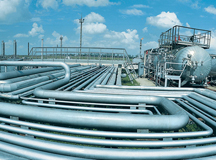 |
 |
|
| eNews • June 2012 | ||
| Promoting a Cost-Effective, Reliable and Competitive Transportation System |
||
 Motor Carriers Turn to Natural Gas as Fuel
Motor Carriers Turn to Natural Gas as Fuel
Motor carriers are adopting natural gas as one of the fuels of choice for their fleets because it makes financial sense, truck manufacturers told the recent Alternative Clean Transportation Expo in Long Beach.
“These are exciting times for natural gas,” said Andy Douglas, national sales manager at Kenworth Truck Co., “and Long Beach is where it all started,” he said.
The clean-truck programs launched by the neighboring ports of Los Angeles and Long Beach in 2008 encouraged the use of heavy-duty trucks powered by compressed natural gas and liquefied natural gas. Modern trucks powered by CNG and LNG produce a significant reduction in pollution compared to older vehicles that run on diesel fuel.
The clean-truck plans mandated the rapid replacement of old trucks with 2007 model year or newer trucks powered either by clean diesel or natural gas. The ports earlier this year reported that truck pollution in Los Angeles-Long Beach harbor has been slashed by about 90 percent from the 2005 baseline year.
Although natural-gas powered trucks represent a small percentage of the total national truck fleet because the trucks are more costly and the nation lacks an extensive natural gas fueling infrastructure, a convergence of factors indicates the use of natural gas will accelerate.
The main reason why natural gas is becoming popular is the declining price of gas compared to diesel. Development of shale deposits in the U.S. has produced a glut of natural gas, sending the price down to about half of the price of diesel.
“The fuel price differential keeps getting better,” said Brian Daniels, product manager, powertrain, at Daimler Trucks North America.
Furthermore, natural gas suppliers are expanding the fueling infrastructure along major highways. What started as a fueling infrastructure serving the ports of Los Angeles and Long Beach is becoming a national network that will serve many busy truck corridors. Within two years, the natural gas infrastructure in many corridors will resemble what Southern California looks today, Douglas said.
Heavy-duty trucks powered by natural gas retain most of the same truck parts found in diesel-powered vehicles. The big difference, Douglas said, is in the fuel tanks, which tend to be larger and heavier.
Large retailers and third-party logistics providers are urging motor carriers to incorporate more natural gas trucks into their fleets. Retailers are then able to use the carbon emissions reductions in their corporate responsibility marketing efforts.
Douglas said that in the future possibly 10 percent of annual heavy-duty truck sales will be natural gas-powered vehicles.
Source: Journal of Commerce
Soy Transportation Coalition |
|
